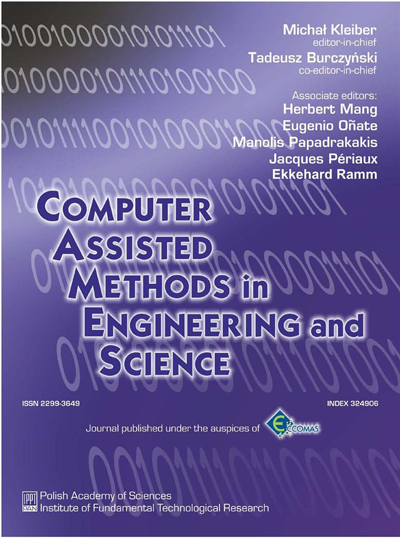Hybrid Monte Carlo method in the reliability analysis of structures
Abstract
The paper develops the idea of [8], i.e., the application of Artificial Neural Networks (ANNs) in probabilistic reliability analysis of structures achieved by means of Monte Carlo (MC) simulation. In this method, a feed-forward neural network is used for generating samples in the MC simulation. The patterns for network training and testing are computed by a Finite Element Method (FEM) program. A high numerical efficiency of this Hybrid Monte Carlo Method (HMC) is illustrated by two examples of the reliability analysis that refer to a steel girder [4] and a cylindrical steel shell [2].
Keywords
reliability, Artificial Neural Networks (ANNs), Finite Element Method (FEM), Hybrid Monte Carlo Method (HMC), steel girder, cylindrical steel shell,References
[1] J. Kaliszuk. Reliability analysis of construction and construction elements using artificial neural networks (in Polish). Ph.D. Thesis, University of Zielona Góra, 2005.[2] J. Kaliszuk. Updating of FEM Models for laboratory tests on cylindrical panels and their reliability analysis by the hybrid FEM/ANN Monte Carlo method. In: A. Borkowski, T. Lewiński, [Eds.],19th International Conference on Computer Methods in Mechanics. Short Papers, 235-236, Publishing House of the Warsaw University of Technology, Warszawa, 2011.
[3] J. Kaliszuk, J. Marcinowski, Z. Waszczyszyn. Experimental Investigation and Numerical Modelling of Large Displacements of Elasto-plastic Cylindrical Shell. In: W. Pietraszkiewicz, C. Szymczak, [Eds.], SSTA 8: Shell Structures: Theory and Applications, Proceedings of the 8th SSTA Conference, 477–480. Taylor & Francis, London, 2005.
[4] J. Kaliszuk, Z. Waszczyszyn. Reliability analysis of a steel girder by the hybrid FEM/BPNN Monte Carlo method. In: M.A. Giżejowski, A. Kozłowski et al., [Eds.], Progress in Steel, Composite and Aluminium Structures: Proc. XIth Intern. Conf. on Metal Structures, 346–347. Taylor& Francis Group, London, 2006.
[5] M. Królak. Postcritical behaviour and load carrying capacity of thin-walled girders (in Polish). PWN, Warszawa, 1990.
[6] P. Marek, M. Guštar, Th. Anagnos. Probabilistic Assessment of Structures using Monte Carlo Simulation. TeReCo, 2001.
[7] E. Pabisek, J. Kaliszuk, Z. Waszczyszyn. Neural and finite element analysis of a plane steel frame reliability by the Classical Monte Carlo method. In: L. Rutkowski, J. Siekmann, R. Tadeusiewicz, L.A. Zadeh, [Eds.], Artificial Intelligence and Soft Computing, Proc. 7th Intern. Conf., Zakopane, 2004, 1081–1086. Springer, Heidelberg, 2004.
[8] M. Papadrakakis, V. Papadopoulos, N.D. Lagaros. Structural reliability analysis of elastic-plastic structures using neural networks and Monte Carlo simulation. Computer Methods in Applied Mechanics and Engineering, 136: 145–163, 1996.
[9] Z. Waszczyszyn, L. Ziemiański. Neural networks in the identification analysis of structural mechanics problems. In: Z. Mróz, G.E. Stavroulakis, [Eds.], Parameter identification of materials and structures. CISM Courses and Lectures, 469: 265–340. Springer, Wien-New York, 2005.
[10] COSMOS/M, Finite element analysis system. Version 2.5. Structural Research and Analysis Corp., California: Los Angeles, 1999.
[11] Neural Network Toolbox for Use with MATLAB, User’s Guide, Version 3. The Math Works, Inc., Natick, MA, 1998.
[12] PN-B-06200. Building steel structures. Requirements for production and control. Basic requirements. PKN, Warszawa, 2002.
[13] PN-EN 1990. Eurocode: Basis of structural design. PKN, Warszawa, 2004.
[14] PN-EN 1993. Eurocode 3: Design of steel structures. PKN, Warszawa, 2006.
Published
Jan 25, 2017
How to Cite
KALISZUK, Joanna.
Hybrid Monte Carlo method in the reliability analysis of structures.
Computer Assisted Methods in Engineering and Science, [S.l.], v. 18, n. 3, p. 205–216, jan. 2017.
ISSN 2956-5839.
Available at: <https://cames.ippt.gov.pl/index.php/cames/article/view/115>. Date accessed: 31 may 2025.
Issue
Section
Articles




